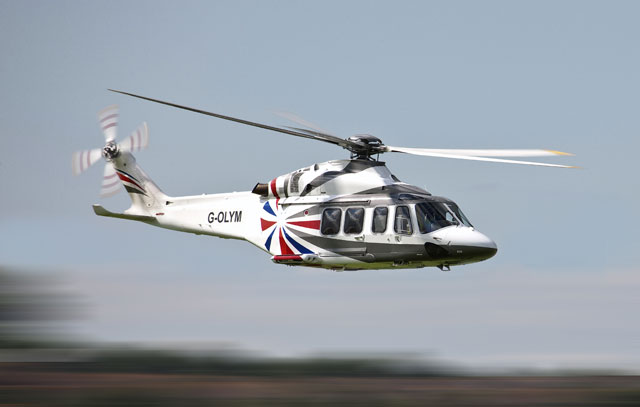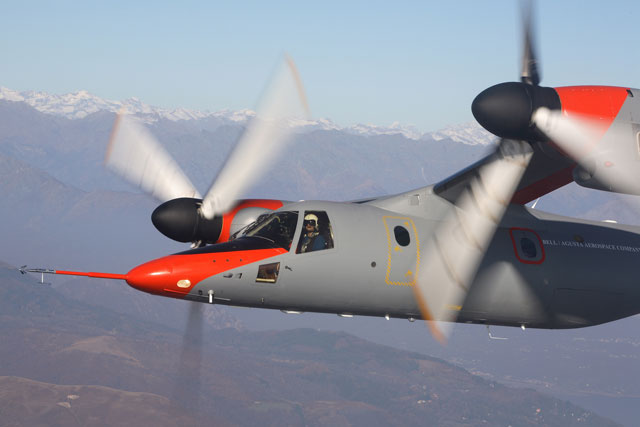Whether transporting engineers to offshore rigs, providing police with eyes in the sky, or whisking VIPs between appointments over traffic-choked cities, the world's appetite for civil helicopters in all their guises is growing - and the reason AgustaWestland has remained one of the strongest performing units within Finmeccanica for the past decade.
Despite a squeeze in defence spending in its home markets of Italy and the UK - as well as the USA - the civil sector remains buoyant for the Lombardy-based rotorcraft specialist. "The commercial market is growing everywhere," says chief executive Bruno Spagnolini. "The focus is on oil and gas, EMS [emergency medical services] and law enforcement."
The next few years promise to be busy for AgustaWestland, which claims to have lifted its share of the $4.17 billion commercial rotorcraft market to 25% between 2004 and 2011, overtaking US rivals Bell and Sikorsky to second place behind Europe's dominant champion Eurocopter. These innovations include what the manufacturer calls the industry's first family of new-generation helicopters.
 |
|---|
AugustaWestland There are more than 500 AW139s in service globally |
The three-strong family is based on the AW139 intermediate-twin, developed with one-time partner Bell, and more than 500 of which are in service. A larger, medium-twin AW189 - and its military sister the AW149 - will be certificated next year, while a light-intermediate "shrink" of the AW139, the AW169, will follow in 2014. All three types flew at July's Farnborough air show.
The three variants share a "cockpit concept" and systems from pilot seats to trim actuators. Many other features are common to two of the helicopters. The family approach is a "significant improvement" for AgustaWestland, says Spagnolini. "The lessons we learned are immediately transferable and the fact that there is a lot of common equipment made for a fast development process."
Although Spagnolini expects few operators to opt for more than one of the models to make the most of cockpit commonality, he says the real benefit for AgustaWestland is from "the industrial point of view - it's a huge achievement". He adds: "Because we can order our seats, for instance, in bigger numbers from the supply chain, we can be more competitive. It is the lesson from the automotive industry."
The other big development for AgustaWestland on the civil side is the AW609. The twin-engined tiltrotor was conceived in the 1990s as a Bell-Boeing project before Agusta took a share. The Italian company then inherited the programme - then called the BA609 - 12 months ago. However, with the project in limbo since the partnership effectively ended six years ago, the transition has been agonisingly slow.
 |
|---|
AugustaWestland AugustaWestland is slowly taking over the former BA609 programme |
Progress is now firmly under way. Integrated teams of AgustaWestland and Bell engineers - the latter working under sub-contract - are working on systems at the Italian company's Cascina Costa headquarters as well as AgustaWestland's facility at Arlington, Virginia. Another team of 150 is based in Fort Worth, Texas. Two prototypes have flown more than 700h, with a third and fourth to join the flight-test programme in 2013 and 2014 respectively.
With such a complicated and lengthy gestation, one hurdle has been the transfer of intellectual property between Bell and AgustaWestland. Bell, for instance, still owns the IP to the rotor blade technology, which must be licensed by its former partner. "We now have a roadmap for the handover of the IP," says programme manager Clive Scott.
Even though certification is not expected before 2016, Spagnolini insists AgustaWestland will retain the market edge over competitors Eurocopter and Sikorsky, both of which have flown high-speed, "compound" designs - although neither the X3 or X2 are conventional tiltrotors like the AW609. "We are still closest to certification," he says. "Other concepts will require 10 years to become a product. That gives us enough time to mature the AW609."
Uncertainty surrounding the project has meant there are no firm commitments for the aircraft. However, Spagnolini says "it is starting to receive interest" from the oil and gas, search and rescue and police markets. "When it gets closer to certification, I'm sure there will be momentum. The original plan was for 400 to 500 orders and we are sticking to that," he says. "We expect to put on to the market a product that is a much more advanced helicopter."
The shift in AgustaWestland's business away from defence has led to a rethink about its Yeovil factory, the original Westland Helicopters, bought out fully by AgustaWestland parent Finmeccanica from former joint owner GKN in 2004. Traditionally an almost exclusively military facility, Yeovil is being "reoriented" as an engineering centre of excellence, helped by $150 million investment shared by AgustaWestland and the UK government.
Military production will remain at the heart of Yeovil - the plant is producing 62 AW159 Lynx Wildcats for the UK Army and Royal Navy and has several sustainment and overhaul contracts. However, more civil work is being introduced, including an assembly line for the AW169 and AW189. Yeovil's 600-strong engineering department has also been "fully integrated" with the 1,000 engineers based at Cascina Costa.
"We are modifying the mentality of the organisation from one serving a single customer to one capable of competing worldwide," says Spagnolini. However, he stresses: "We cannot entirely substitute military activities with commercial. The UK [Ministry of Defence] is still very important and the more we invest in Yeovil, the more the MoD can take advantage."
Although Spagnolini admits the defence spending outlook is "difficult" in Europe and the USA, this is not the case everywhere. "Other markets are not so depressed. In India and the Far East they are continuing to spend, as is South America." Military versions of its new helicopter family are being touted for requirements in Poland and South Korea.
The US defence market remains vital. AgustaWestland is offering the AW169 for the Armed Aerial Scout programme, while it has teamed with Northrop Grumman to bid the AW101 for both the contest to supply a new presidential transport and replace the US Air Force's combat search and rescue fleet. The company previously won the VXX presidential helicopter contest teamed with Lockheed Martin, but the procurement was cancelled.
In industrial terms, AgustaWestland has also been spreading its wings. In Poland, it bought in 2010 one of the former state-owned helicopter concerns, PZL-Swidnik. The factory, which assembles the AW149, as well as its own programmes, and carries out work for third parties, including Bell and Eurocopter, is 50% more efficient than when it was acquired, says Spagnolini, who describes Swidnik as "one of our best facilities".
In Russia, a market Spagnolini calls "very promising", AgustaWestland licenses Russian Helicopters to assemble the AW139 for the local market, and the two companies signed a deal at Farnborough to jointly develop, produce and market a new 2.5t single-engined helicopter. A prototype is expected in two years. Other countries where AgustaWestland is looking to establish possible joint ventures or assembly facilities include Brazil and India.
While India remains one of the few honeypots for defence helicopter manufacturers, Brazil's burgeoning energy, law enforcement and corporate transport markets are the attraction there. In its biggest conurbations, helicopters have become an essential mode of transport for the wealthy but time-poor. "There are 140 helipads in Sao Paulo alone," says Spagnolini. "We expect Brazil to be a huge market for the AW169."
Source: Flight International
















